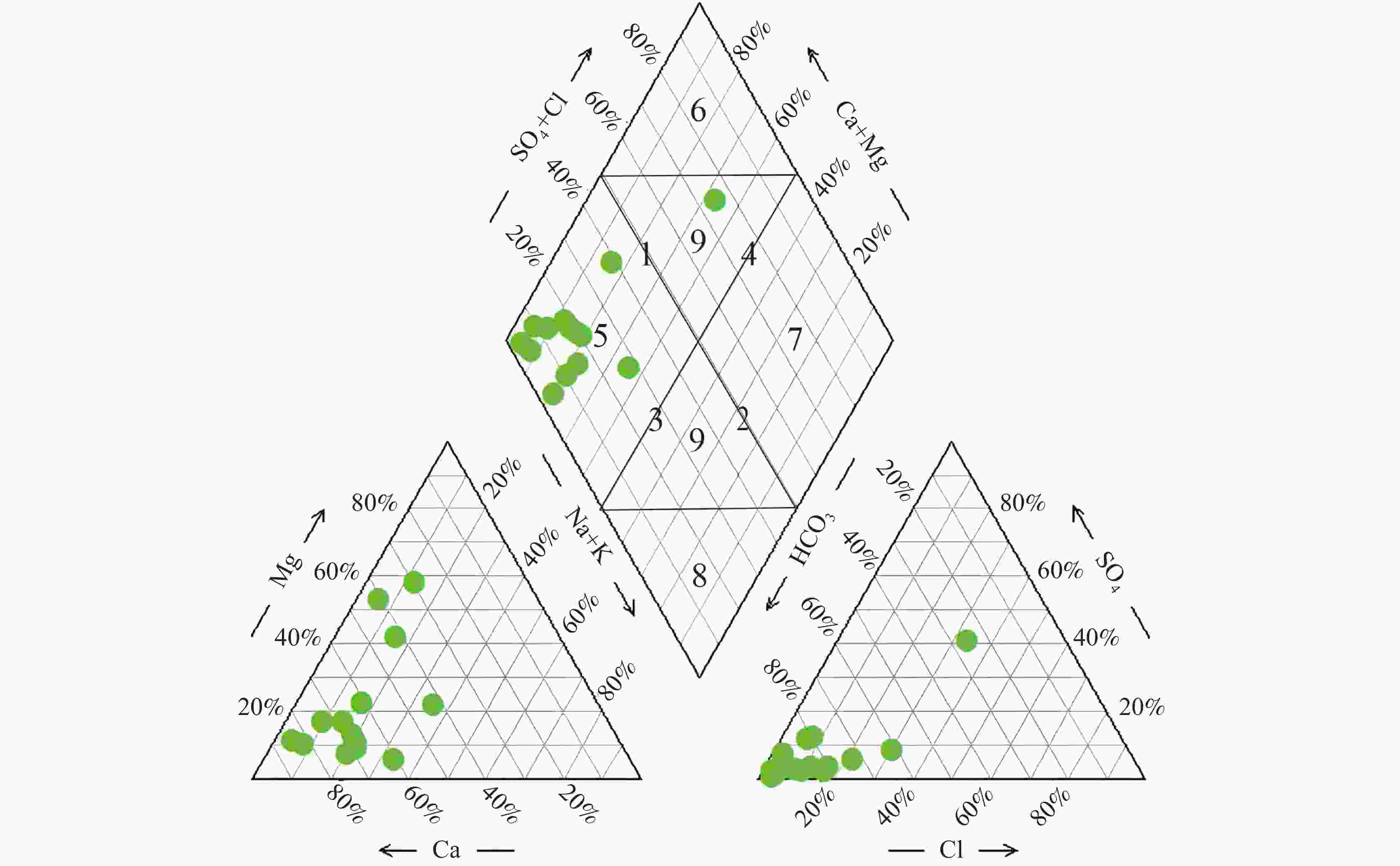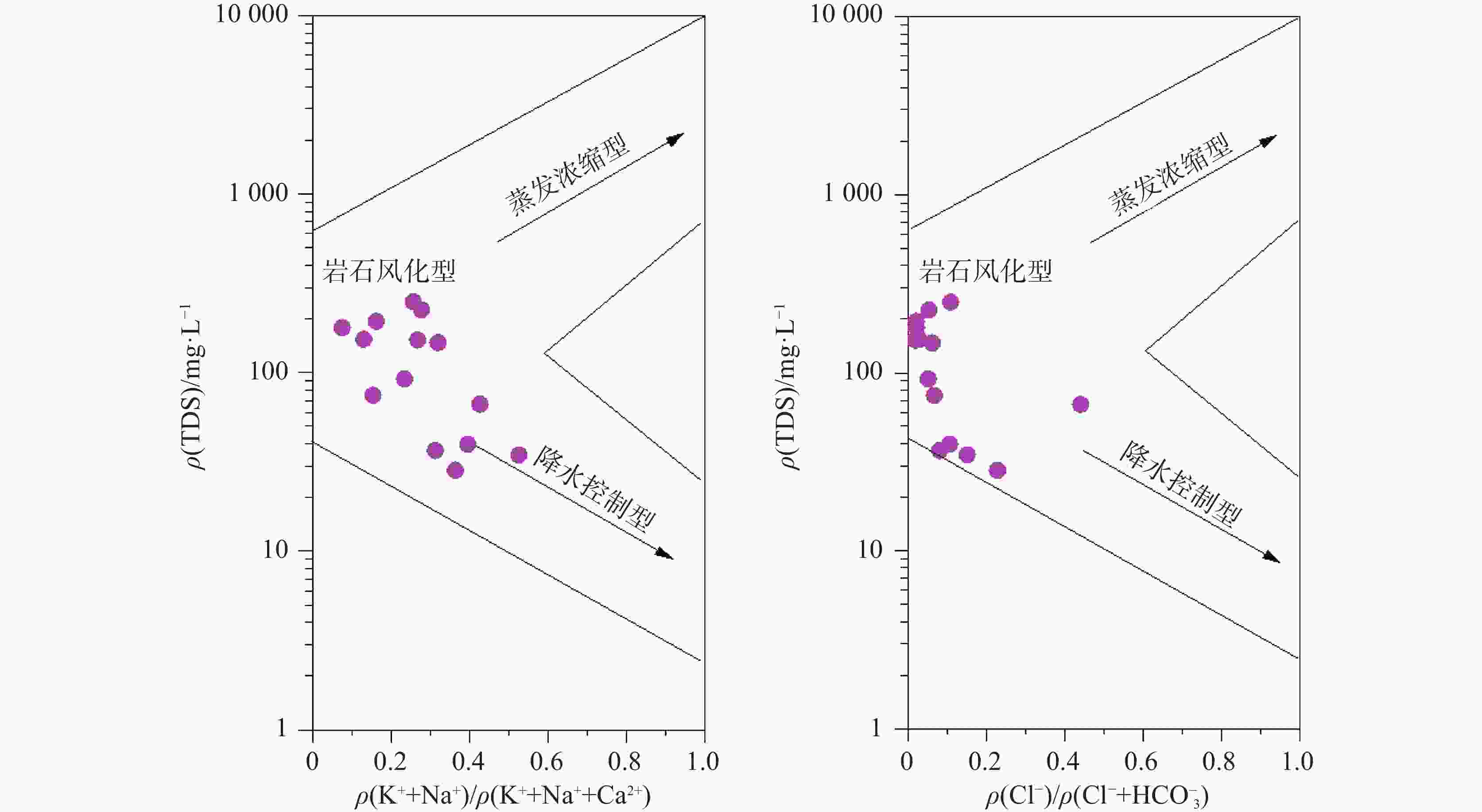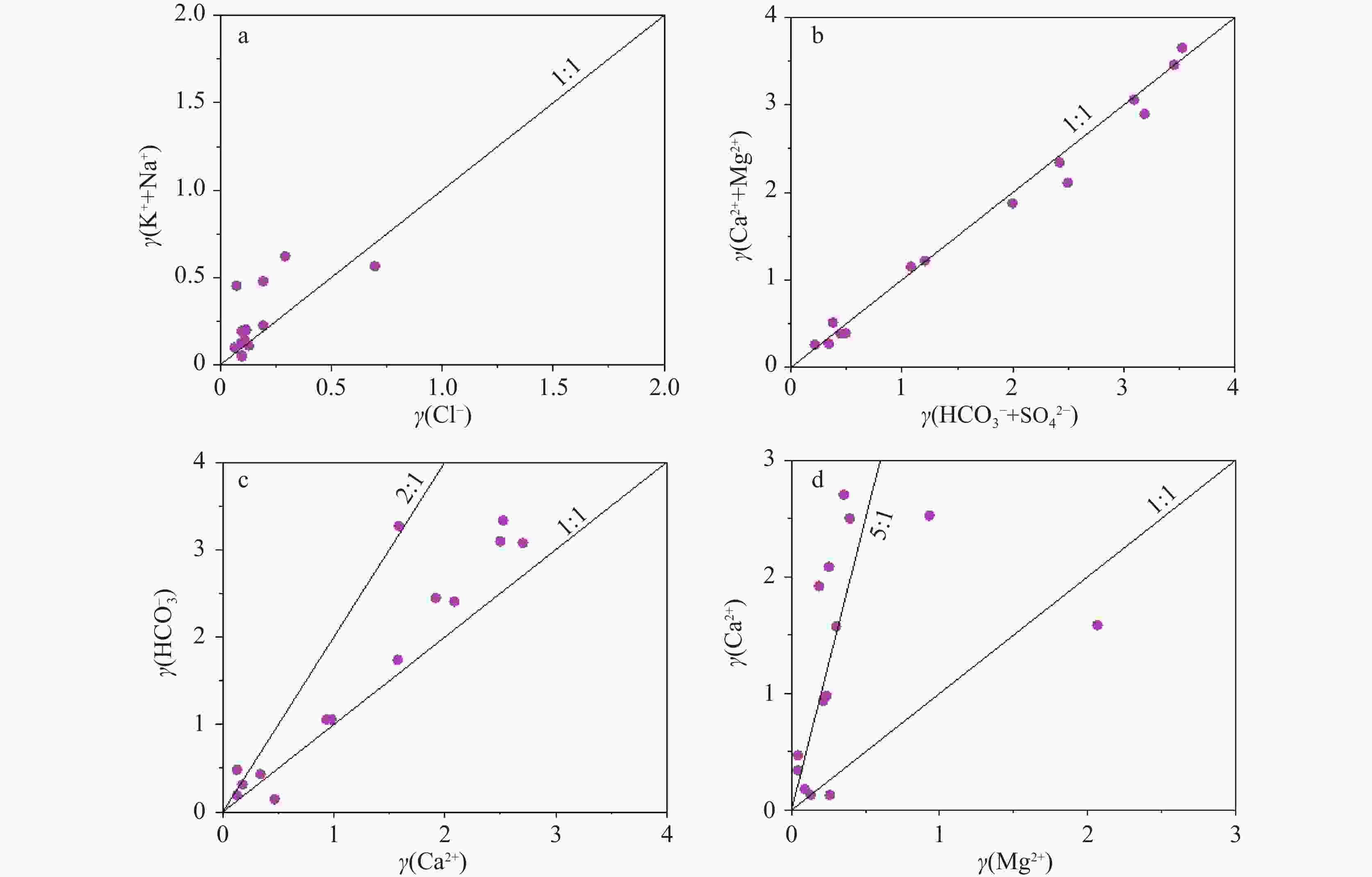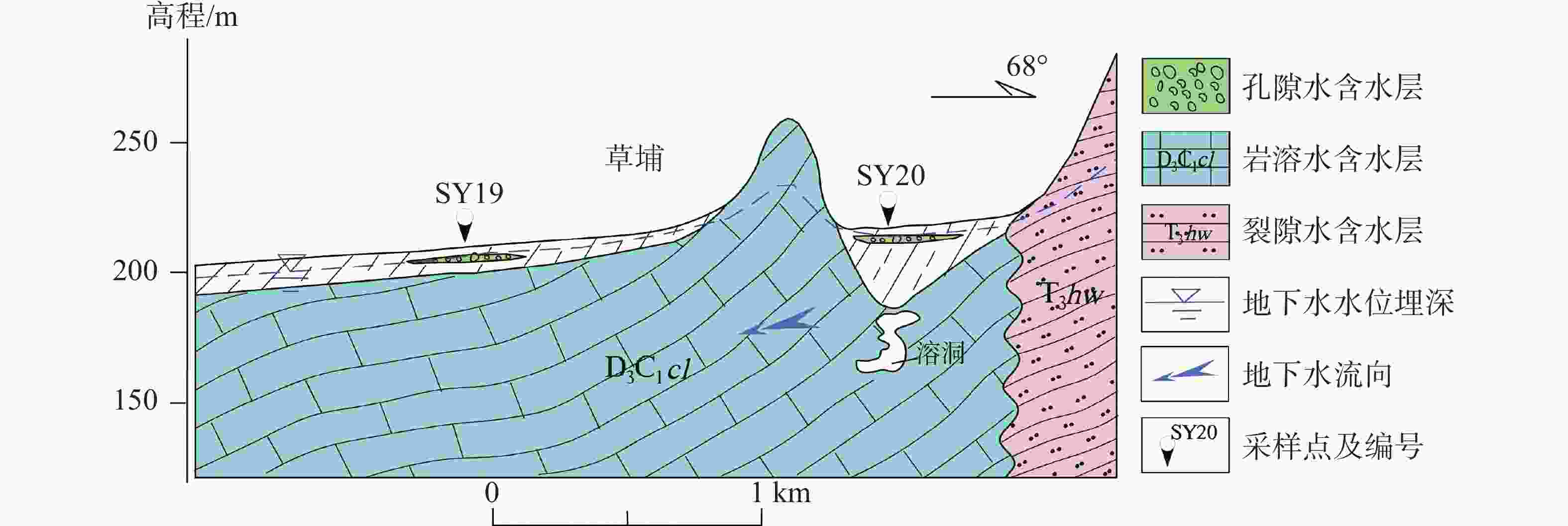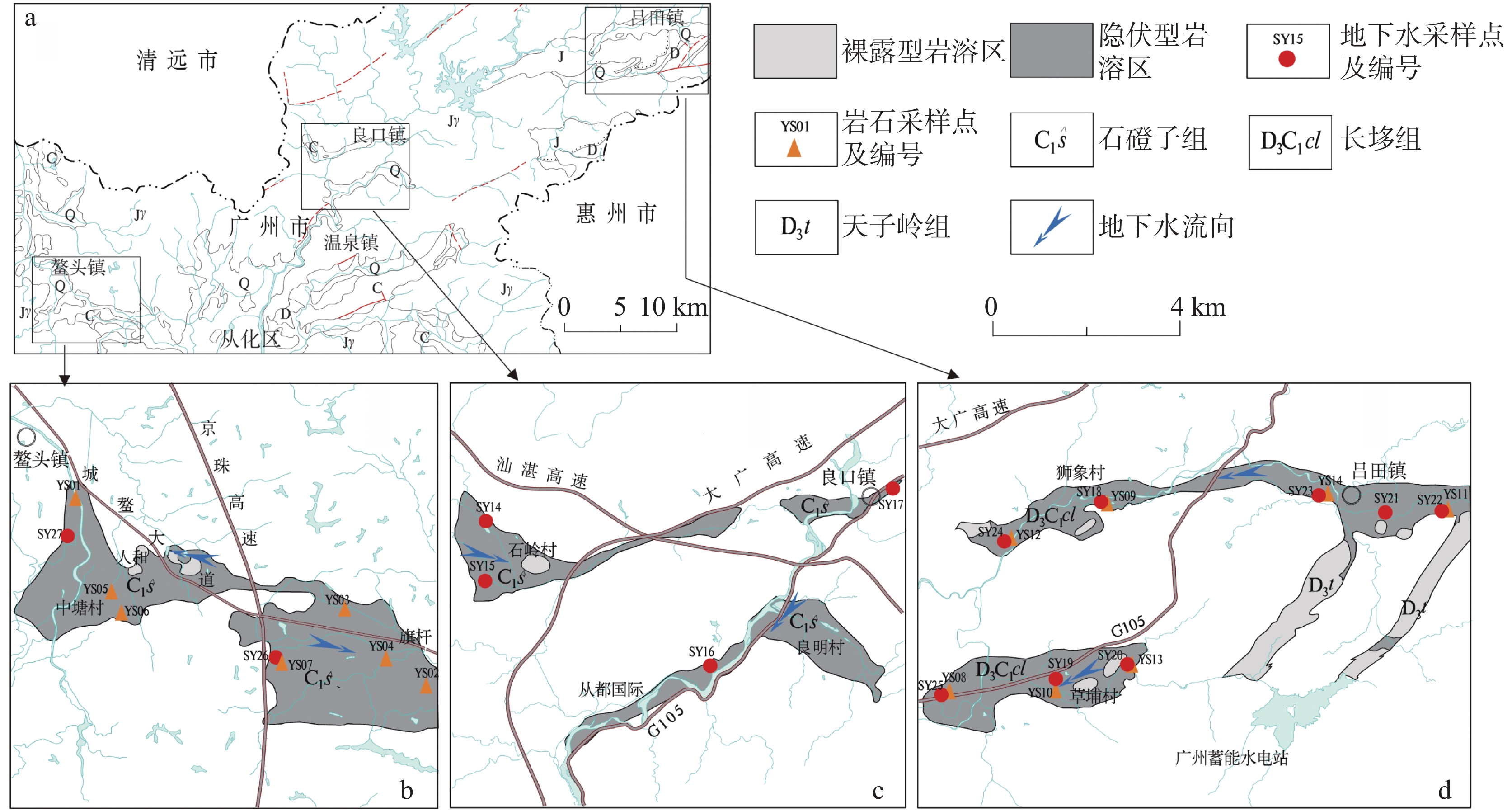Analysis of hydrochemical characteristics and controlling factors of groundwater in the covered karst area of northern Guangzhou
-
摘要: 为研究广州北部隐伏岩溶区地下水水化学特征及形成演化,利用14组岩溶水样品和14件岩石化学组分测试分析数据,综合采用数理统计、Piper图、Gibbs模型、离子比值图、氯碱指数等方法定性分析地下水水化学组分特征和成因,基于PHREEQC软件定量分析水文地球化学过程,探讨地下水矿物饱和指数与岩溶发育关系。结果表明:广州北部隐伏岩溶区岩溶水是以中性水为主的极软~微硬淡水,TDS和总硬度低,pH基本稳定,离子质量浓度趋势为Ca2+>K++Na+>Mg2+和${\rm{HCO}}_3^{-}$>Cl−>${\rm{SO}}_4^{2-}$,水化学类型主要为HCO3型,以${\rm{HCO}}_3^{-}$、Ca2+为优势离子;岩溶水水化学组分受岩石风化作用控制条件下的溶滤作用影响,阳离子交换吸附作用不强烈,K+、Na+、Cl−来源于岩盐溶滤,Ca2+、Mg2+、${\rm{HCO}}_3^{-}$来源于碳酸盐岩矿物溶解,${\rm{SO}}_4^{2-}$来源于碳酸盐岩和石膏等蒸发岩盐溶解;反向水文地球化学模拟定量化验证了岩溶水中方解石、白云石、石膏、岩盐发生溶解;方解石、白云石饱和指数与岩溶发育具有较好对应关系,可以指示岩溶发育趋势。研究结果可为广州隐伏岩溶区地下水开发利用和地质环境保护提供科学依据。Abstract:
Guangzhou is clearly positioned as the core engine of the Guangdong−Hong Kong−Macao Greater Bay Area and shoulders the responsibility of leading the high-quality development of the Greater Bay Area. The northern Guangzhou serves as a demonstration area for urban-rural integration, featuring a distinctive ecological agriculture industry and a functional area for rural tourism. However, the covered karst in this area is highly developed. Consequently, the environmental problems, such as karst ground collapse and the deterioration of groundwater quality, have limited to some extent the local construction and development. In order to study the hydrochemical characteristics and formation of groundwater in the covered karst area of northern Guangzhou. We utilized fourteen groups of karst water samples and fourteen groups of rock chemical composition test data collected during the dry season from 2017 to 2018. We conducted a qualitative analysis of the hydrochemical characteristics and controlling factors of groundwater using mathematical statistics, Piper diagrams, the Gibbs model, ion ratio diagrams, the and chlor-alkali index. Additionally, using the hydrogeochemical reaction simulation software PHREEQC, we performed a quantitative analysis of the hydrogeochemical processes, with a particular emphasis on the dissolution−precipitation equilibrium of minerals in groundwater. The results show, (1) The karst water in the covered karst area of northern Guangzhou is characterized as extremely soft to slightly hard, neutral, and fresh. The total dissolved solids (TDS) and total hardness of the karst water are low, and the pH remains relatively stable. The dominant anion and cation are ${\rm{HCO}}_3^{-}$ and Ca2+, respectively. The trend of ion concentrations is Ca2+>K++Na+>Mg2+ and ${\rm{HCO}}_3^{-}$ >Cl−>${\rm{SO}}_4^{2-}$ , respectively. The hydrochemical types of karst water are primarily of the HCO3 type. (2) The ρ(K++Na+)/ρ(K++Na++Ca2+) of karst water ranges from 0.1 to 0.6, and the ρ(Cl−)/ρ (Cl−+${\rm{HCO}}_3^{-}$ ) ranges from 0.1 to 0.5. The chlor-alkali indices (CAI1 and CAI2) mainly fall within the ranges of -2 to 1 and -0.25 to 0.25, respectively, indicating weak cation exchange adsorption. In 78.57% of the water samples, the ratio of γ(K++ Na+) to γ(Cl−) ions is at or above the 1∶1 line, indicating that K+, Na+ and Cl− primarily originate from the dissolution of rock salt. The ratios of γ(Ca2++Mg2+) to γ(${\rm{HCO}}_3^{-}$ + ${\rm{SO}}_4^{2-}$ ) ions are concentrated near or above the 1∶1 line. Furthermore, 85.71% of the water samples display ratios of γ(Ca2+) to γ(${\rm{HCO}}_3^{-}$) ions that are either near the 1∶1 line or between the 1∶1 line and 2∶1 line. Additionally, 85.71% of the water samples exhibit ratios of γ(Ca2+) to γ(Mg2+) ions above the 1∶1 line. These findings suggest that Ca2+, Mg2+ and ${\rm{HCO}}_3^{-}$ ions are derived from the dissolution of carbonate minerals, while ${\rm{SO}}_4^{2-}$ ions originate from the dissolution of carbonate rocks and evaporitic salts, such as gypsum. (3) The lithology of covered karst is dominated by limestone, followed by dolomite limestone. The ratio of CaO to MgO in the rock chemical composition of limestone (19.36−119.73) is much larger than that of dolomitic limestone (1.43−4.71), and the dissolution ability of limestone is obviously stronger than that of dolomitic limestone. (4) PHREEQC software has been used to establish a reverse hydrogeochemical model in the rock sampling points from SY20 to SY19 in the Caopu area of Lyutian Town . The simulation results quantitatively confirmed the dissolution of calcite, dolomite, gypsum, and rock salt in karst water, with respective dissolution amounts of 2.599×10−4 mol·L−1, 8.474×10−5 mol·L−1, 4.165×10−6 mol·L−1, and 3.446×10−5 mol·L−1. (5) The saturation indices of calcite and dolomite in karst water show a good correspondence with karst development. Among the water sampling points where calcite is in a good dissolved state, 85.71% of the points exhibit karst development. In contrast, among the water sampling points where dolomite is in a dissolved state, 66.67% of the points exhibit karst development. The saturation indices of calcite and dolomite in groundwater indicate the trend of karst development and can serve as criteria for fine evaluation of karst development. This study reveals the hydrochemical characteristics of groundwater, as well as its formation and evolution in the covered karst area of northern Guangzhou. It also explores the relationship between groundwater mineral saturation indices and karst development. The research findings can provide a scientific basis for the exploitation and utilization of groundwater and for the protection of geological environment in the covered karst area of Guangzhou, which holds significant practical implications. -
表 1 地下水水化学组分统计表
Table 1. Statistics of groundwater hydrochemical composition
统计项目 组分质量浓度/mg·L−1 TDS/mg·L−1 总硬度/mg·L−1 pH K++Na+ Ca2+ Mg2+ Cl− SO$_4^{2-} $ HCO$_3^- $ 最大值 19.27 54.11 24.81 24.74 12.40 203.38 249.02 181.00 7.95 最小值 1.47 2.56 0.52 2.30 0.57 8.80 28.30 12.80 6.65 平均值 7.80 25.80 4.72 6.03 4.43 100.40 119.40 83.84 7.29 变异系数 0.77 0.74 1.35 0.96 1.03 0.76 0.63 0.74 0.05 表 2 可能的矿物相及化学反应方程
Table 2. Possible mineral phases and chemical reaction equations
可能矿物相 化学反应方程 方解石 CaCO3+H2O=Ca2++${\rm{HCO}}_3^{-}$+OH− 白云石 CaMg(CO3)2+2H2O=Ca2++Mg2++2${\rm{HCO}}_3^{-}$+2OH− 石膏 CaSO4·2H2O=Ca2++${\rm{SO}}_4^{2-}$+2H2O 岩盐 NaCl=Na++Cl− CO2 CO2+H2O=H2CO3 表 3 水岩相互作用下矿物相转移量
Table 3. Mineral transfer amount during water-rock interaction
路径 可能的矿物相/mol·L−1 方解石 白云石 石膏 岩盐 SY20→SY19 2.599×10−4 8.474×10−5 4.165×10−6 3.446×10−5 注:正数表示矿物发生溶解作用,负数表示矿物发生沉淀作用;阳离子交换中,正值表示Ca2+降低以及溶液中Na+的升高;负值表示Ca2+升高以及溶液中Na+的降低.“—”表示该矿物相未参加反应或未模拟出。 -
[1] 张人权, 梁杏, 靳孟贵, 万力, 于青春. 水文地质学基础( 第六版)[M].北京: 地质出版社, 2011.ZHANG Renquan, LIANG Xing, JIN Menggui, WAN Li, YU Qingchun. Fundamentals of hydrogeology(6th Edition)[M]. Beijing: Geological Publishing House, 2011. [2] 苏东, 龚绪龙, 杨磊, 黄敬军, 许书刚, 龚亚兵, 崔龙玉. 常州市地下水化学特征与成因分析[J]. 地质论评, 2023, 69(3):1039-1049.SU Dong, GONG Xulong, YANG Lei, HUANG Jingjun, XU Shugang, GONG Yabing, CUI Longyu. Hydrogeochemical characteristics and controlling factors of groundwater in Changzhou[J]. Geological Review, 2023, 69(3): 1039-1049. [3] 史箫笛, 康小兵, 许模, 邓宏科. 川滇高原斜坡地带峡谷区岩溶水化学特征及演化规律[J]. 地质学报, 2019, 93(11):2975-2984.SHI Xiaodi, KANG Xiaobing, XU Mo, DENG Hongke. Hydrochemical characteristics and evolution laws of karst grounderwater in the slope zone of the canyon area, Sichuan-Yunnan Plateau[J]. Acta Geologica Sinica, 2019, 93(11): 2975-2984. [4] 屈秋楠, 宋小庆, 唐娱杰, 杨振华. 地下含水层水资源赋存条件及其水化学特征: 以贵州省安龙县幅为例[J]. 中国岩溶, 2019, 38(3): 378-387.QU Qiunan, SONG Xiaoqing, TANG Yujie, YANG Zhenhua. Groundwater occurrence condition and hydrochemical characteristics: A case study of Anlong county map sheet in Guizhou Province[J]. Carsologica Sinica, 2019, 38(3): 378-387. [5] 唐金平, 张强, 胡漾, 邵江, 何文君, 张宇. 巴中北部岩溶山区地下水化学特征及演化分析[J]. 环境科学, 2019, 40(10):4543-4552.TANG Jinping, ZHANG Qiang, HU Yang, SHAO Jiang, HE Wenjun, ZHANG Yu. Hydrochemical characteristics of karst groundwater in the mountains of northern Bazhong city, China[J]. Environmental Science, 2019, 40(10): 4543-4552. [6] 蒙彦. 广花盆地岩溶塌陷多参数监测预警与风险防控[D]. 武汉:中国地质大学, 2020.MENG Yan. Multi-parameter monitoring, early warning and risk prevention of karst collapse in Guanghua Basin[D]. Wuhan: China University of Geosciences, 2020. [7] 侯文隽, 龚星, 刘锋, 李红中. 碳酸盐岩水热协同混合溶蚀作用机理的数值试验研究[J]. 中国岩溶, 2023, 42(4):775-784.HOU Wenjuan, GONG Xing, LIU Feng, LI Hongzhong. Numerical experiment on the mechanism of mixing corrosion of carbonate rocks by hydrothermal synergistic effect[J]. Carsologica Sinica, 2023, 42(4): 775-784. [8] Débora Maria Diniz Barbosa, Rodrigo Sérgio De Paula, Leila Nunes Menegasse Velásquez, Matheus Alonso Castelo Pen. Hydrogeochemistry of aquifers in the northern portion of the Lagoa Santa Karst Environmental Protection Area and surroundings, state of Minas Gerais, Brazil[J]. Journal of South American Earth Sciences, 2024, 144: 105042. doi: 10.1016/j.jsames.2024.105042 [9] Moran-Ramírez J, Ramos-Leal J A, Mahlknecht J, Santacruz-DeLeón G, Martín-Romero F, Fuentes Rivas R, Mora A. Modeling of groundwater processes in a karstic aquifer of Sierra Madre Oriental, Mexico[J]. Applied Geochemistry, 2018, 95: 97-109. doi: 10.1016/j.apgeochem.2018.05.011 [10] 郝艳茹, 王鹏, 张明珠, 张晋, 李丹, 庞园. 广花盆地地下水化学特征及其演化分析[J]. 生态环境学报, 2020, 29(2):337-344.HAO Yanru, WANG Peng, ZHANG Mingzhu, ZHANG Jin, LI Dan, PANG Yuan. Hydrochemical characteristic and its driving force of groundwater in the covered Karst in Pearl River basin[J]. Ecology and Environmental Sciences, 2020, 29(2): 337-344. [11] 张明珠, 朱嵩, 曾慧, 庞园. 帽峰山地区地下水化学时空分布特征分析与污染评价[J]. 环境工程, 2018, 36(10):135-139.ZHANG Mingzhu, ZHU Song, ZENG Hui, PANG Yuan. Spatial and seasonal geochemical characteristics and contamination assessment of groundwater in MaoFeng mountain area[J]. Environmental Engineering, 2018, 36(10): 135-139. [12] 王忠忠, 黄文龙, 庄卓涵, 胡飞跃, 刘广宁. 珠三角丘陵山区岩溶塌陷发育特征及地质模式:以广州北部为例[J]. 地质与勘探, 2023, 59(6):1304-1314. doi: 10.12134/j.dzykt.2023.06.015WANG Zhongzhong, HUANG Wenlong, ZHUANG Zhuohan, HU Feiyue, LIU Guangning. Development features and geological models of karst collapse in hilly areas of the Pearl River Delta: A case study of northern Guangzhou[J]. Geology and Exploration, 2023, 59(6): 1304-1314. doi: 10.12134/j.dzykt.2023.06.015 [13] 苗迎, 孔祥胜, 宋朝静. 南宁市区地下水水化学特征及形成机制[J]. 中国岩溶, 2015, 34(3):228-233.MIAO Ying, KONG Xiangsheng, SONG Zhaojing. Hydrochemical characteristics and formation mechanism of groudwater in Nanning City[J]. Carsologica Sinica, 2015, 34(3): 228-233. [14] 徐建华. 现代地理学中的数学方法[M]. 北京: 高等教育出版社, 2017.XU Jianhua. Mathematical methods in contemporary geography[M]. Beijing: Higher Education Press, 2017. [15] 孙丰英. 淮南煤田岩溶地下水化学特征及形成机制研究[D]. 淮南:安徽理工大学, 2021.SUN Fengying. Study on hydrochemical characteristics and formation mechanism of karst groundwater in Huainan coalfield[D]. Huainan: Anhui University of Science and Technology, 2021. [16] William J. Deutsch, Randy Siegel. Groundwater geochemistry. Fundamentals and applications to contamination[M]. New Jersey: CRC Press, 1997. [17] 沈照理. 水文地球化学基础[M]. 北京: 地质出版社, 1986: 87-88.SHEN Zhaoli. Hydrogeochemical basis[M]. Beijing: Geological Publishing House, 1986: 87-88. [18] 王金金. 北京平谷平原区浅层地下水化学特征演化研究[D].成都:成都理工大学, 2020.WANG Jinjin. Study on evolution of chemical characteristics of shallow groundwater in Pinggu plain of Beijing[D].Chengdu: China University of Geosciences, 2020. [19] 刘绍, 肖长来, 梁秀娟, 刘伟, 李明乾, 张芷豪. 双辽市地下水水文地球化学演化规律研究[J]. 中国农村水利水电, 2021(9):85-90, 95.LIU Shao, XIAO Changlai, LIANG Xiujuan, LIU Wei, LI Mingqian, ZHANG Zhihao. Research on the evolution law of hydrochemical chemistry of groundwater in Shuangliao city[J]. China Rural Water and Hydropower, 2021(9): 85-90, 95. [20] 广东省地质矿产局. 广东省区域地质志[M]. 北京: 地质出版社, 1988.Guangdong Geology and Mineral Resources Bureau. Regional geology of Guangdong Province[M]. Beijing: Geological Publishing House, 1988. [21] HUANG Qibo, QIN Xiaoqun, LIU Pengyu, CHENG Ruirui, LI Tengfang. Regional evolution and control factors of karst groundwater in Liulin spring catchment[J]. Environmental Science, 2019, 40(5): 2132-2142. [22] 柳浩然, 张文强, 刘文, 马雪莹, 关琴, 张海林. 基于长期监测的济南趵突泉水文地球化学演化规律研究[J]. 中国岩溶, 2023, 42(5):1-13.LIU Haoran, ZHANG Wenqiang, LIU Wen, MA Xueying, GUAN Qin, ZHANG Hailin. Hydrogeochemical evolution characteristics of Jinan Baotu Spring based on long-term monitoring[J]. Carsologica Sinica, 2023, 42(5): 1-13. [23] 刘影, 王中美, 杨秀丽, 罗和平, 李宗发. 贵安新区东部岩溶地下水水化学特征[J]. 长江科学院院报, 2022, 39(1):39-46. doi: 10.11988/ckyyb.20200877LIU Ying, WANG Zhongmei, YANG Xiuli, LUO Heping, LI Zongfa. Analysis of hydrochemical characteristics of karst groundwater in the east of Gui'an New Area[J]. Journal of Changjiang River Scientific Research Institute, 2022, 39(1): 39-46. doi: 10.11988/ckyyb.20200877 [24] GUO Yongli, ZHANG Cheng, XIAO Qiong, BU Hua. Hydrogeochemical characteristics of a closed karst groundwater basin in North China[J]. Journal of Radioanalytical and Nuclear Chemistry, 2020, 325(3): 365-379. [25] 王瑞, 李潇瀚. 百泉泉域岩溶地下水水化学演化特征及成因[J]. 中国岩溶, 2021, 40(3):398-408.WANG Rui, LI Xiaohan. Hydrochemical characteristics and formation causes of karst groundwater in Baiquan spring catchment[J]. Carsologica Sinica, 2021, 40(3): 398-408. [26] 龚亚兵, 龚绪龙, 许书刚, 唐鑫, 苏东, 吴夏懿. 苏南地区地下水化学特征及演化分析[J]. 地质论评, 2022, 68(6): 2207-2218.GONG Yabing , GONG Xulong, XU Shugang, TANG Xin, SU Dong, WU Xiayi. Hydrogeochemical characteristics and evolution of groundwater in southern Jiangsu[J]. Geological Review, 2022, 68(6): 2207-2218. [27] WEN Yao, QIU Jiahao, CHENG Si, XU Changchang, GAO Xiaojiang. Hydrochemical evolution mechanisms of shallow groundwater and its quality assessment in the estuarine coastal zone: A case study of Qidong, China[J]. International Journal of Environmental Research and Public Health, 2020, 17(10): 3382-3407. doi: 10.3390/ijerph17103382 [28] 姚锦梅, 周训, 李娟, 戴文育, 康星洪. 广东雷州半岛玄武岩地下水水文地球化学特征及演化模拟[J]. 地质通报, 2007, 26(3): 327-334.YAO Jinmei, ZHOU Xun, LI Juan, DAI Wenyu, KANG Xinghong. Hydrogeochemical characteristics and evolution simulation of groundwater in basalts on the Leizhou Peninsula, Guangdong, China. Geological Bulletin of China, 2007, 26(3): 327-334. [29] YANG Nuan, WANG Guangcai, SHI Zheming, ZHAO Dan, JIANG Wanjun, GUO Liang, LIAO Fu, ZHOU Pengpeng. Application of multiple approaches to investigate the hydrochemistry evolution of groundwater in an arid region: Nomhon, northwestern China[J]. Water, 2018, 10(11): 1667-1685. doi: 10.3390/w10111667 [30] 曹振东, 危润初, 段启杉, 谭廷静. 犀牛洞地下河水—岩作用反向模拟[J]. 人民黄河, 2012, 34(10):74-76.CAO Zhendong, WEl Runchu, DUAN QiShan, TAN Tingjing. Inverse geochemical simulation of water-rock interaction of Xiniudong underground river of Xinniu cave[J]. Yellow River, 2012, 34(10): 74-76. [31] 郭钰颖, 吕智超, 王广才, 马栾, 许庆宇, 黄旭娟, 高树志. 峰峰矿区东部地下水水文地球化学模拟[J]. 煤田地质与勘探, 2016, 44(6):101-105.GUO Yuying, LYU Zhichao, WANG Guangcai, MA Luan, XU Qingyu, HUANG Xujuan, GAO Shuzhi. Hydrogeochemical simulation of groundwater in Eastern Fengfeng mining area[J]. Coal Geology & Exploration, 2016, 44(6): 101-105. [32] 李义连, 王焰新, 周来茹, 高红波, 张江华. 地下水矿物饱和度的水文地球化学模拟分析:以娘子关泉域岩溶水为例[J]. 地质科技情报, 2002(1):32-36.LI Yilian, WANG Yanxin, ZHOU Lairu, GAO Hongbo, ZHANG Jianghua. Hydrogeochemical modeling on saturation of minerals in groundwater: a case study at Niangziguan, northern China[J]. Bulletin of Geological Science and Technology, 2002(1): 32-36. -




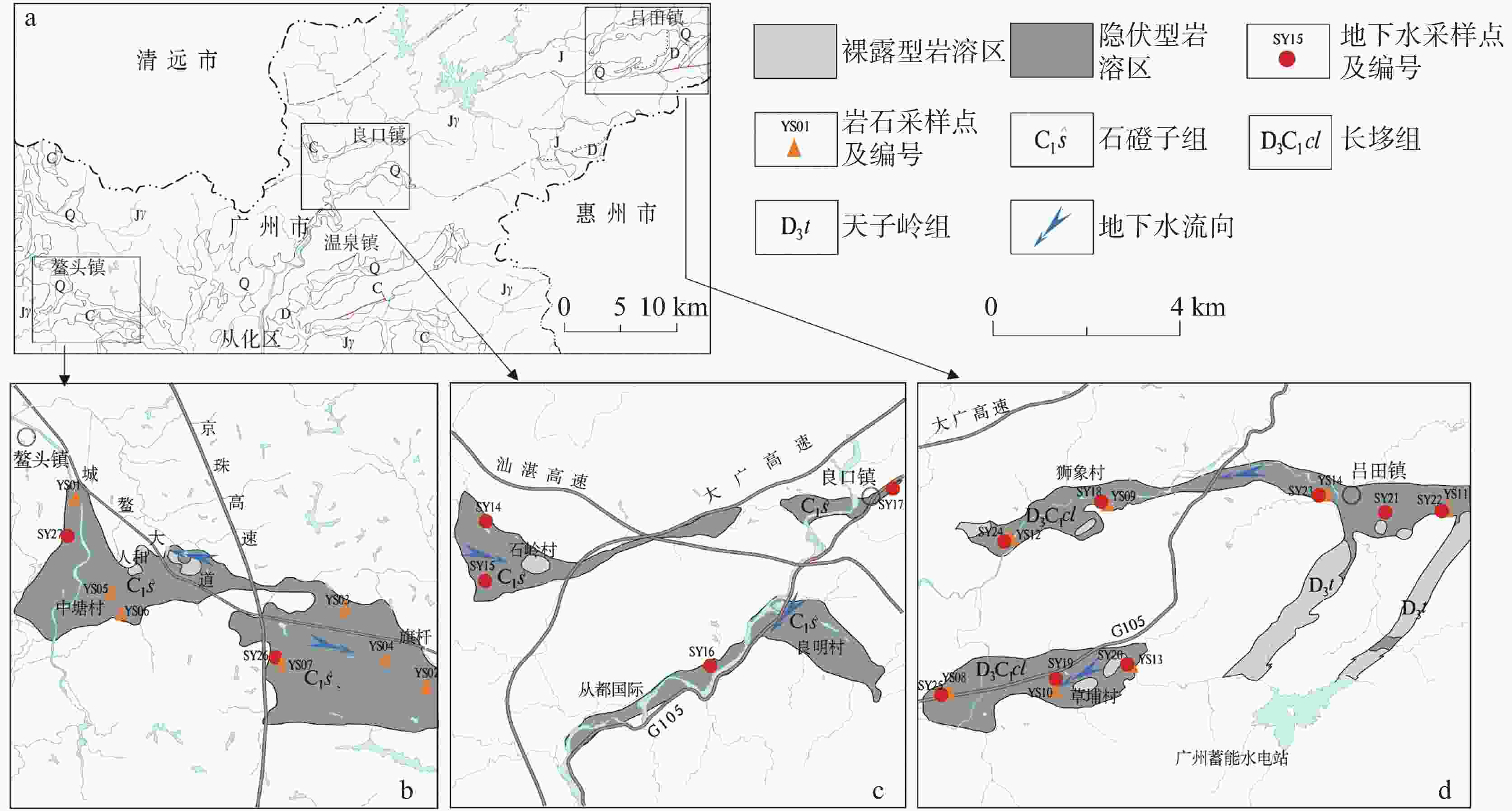
 下载:
下载:
